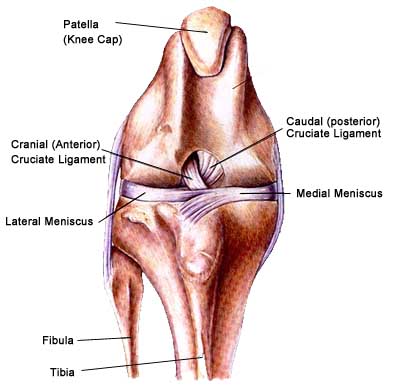This is a common question for pet owners. The most common cause of this “clicking sound” is a meniscal tear. Let me explain this in a little more detail.
It is important that we first understand a few things about your dog’s knee. Often when a dog tears its cranial cruciate ligament there is the potential that it can also injure the meniscus in the joint. This injury is a direct result of either the initial injury itself or due to continuing instability in the joint.
The meniscus is essentially the knee joint’s “pillow” that helps to provide stability and some cushion in between the bones.

It is also important to understand that there are several different types of meniscal injuries but the most common type with a dog ACL tear is referred to as a “bucket-handle tear” in the medial meniscus.
The real question is what should you do about it? Does it require surgery? Or are there conservative management options for this kind of injury?
*As always it is important to consult with your veterinary surgeon or general practitioner to define your best option for your dog because every dog and every situation is unique.
That said here is how we consult our clients who are in this situation.
1) Clicking without Limp: The most important thing to identify is if the “clicking” also corresponds to any discomfort or limping. Many times pet owners will describe this sound to me and if we are certain that it is not related to discomfort or any loss of function, then I prescribe them a high-quality joint supplement, packed with everything the joint needs to be healthy (i.e. GlycanAid® HA) and I tell them to just give it time, in addition to basic physical therapy principles for recovery ie. Rest and Icing to decrease swelling. In the vast majority of these cases, the sound eventually goes away and all is well.
Question: Can a meniscus tear heal on its own? The answer to this is 100% yes, BUT it all depends on the type of tear and the degree of tear. On the outer part of the meniscus, there is a good blood supply and therefore if there is blood it can heal. On the other hand, the inner section of the meniscus does not have a good blood supply and therefore is more likely not to heal. Again it all comes down to if your dog is limping or in discomfort.
2) Clicking with Limp
On the other hand, if your dog has a limp associated with the “clicking” sound then in most cases this would require a surgical procedure to remove/trim the section of the meniscus that is torn. This can be done with minimal invasiveness utilizing arthroscopy.
Bonus Material: Do you know how to spot the silent signs of pain in your dog?
Nobody knows your dog better than you do. Yet often our dogs have an amazing way of hiding things from us, even though we are so close to them daily. This is especially true when it comes to hiding joint pain and discomfort.
Read through this list and see if your dog shows any of these “Early Indicators” of joint problems. If you do notice one or more of these signs in your dog, make sure to contact your veterinarian to discuss available options with a focus on natural solutions as a first line of defense.
SIGN UP FOR NEWS AND TREATSNever Miss Out!




